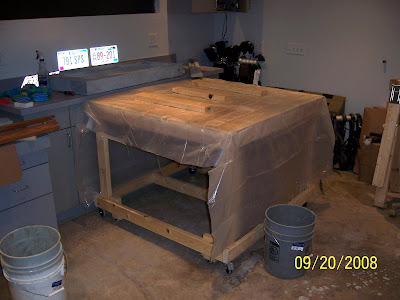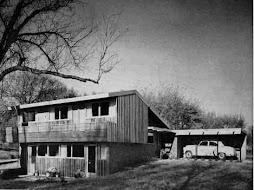Alright, pour day is finally here. The mold is finished, equipment is laid out, and materials are prepped. Showtime. This is where the lighting and garage space come in handy. One nice thing about having a degree in concrete materials and a testing lab is that I can optimize the chemical components to invent new concrete mixtures. The mixture proportions we used was a complicated concoction I came up with earlier this summer. The test samples had 1000 psi tensile strength at one day so we are going without any reinforcement. Ultimate compressive strength on this mixture should be close to 20,000 psi. FYI, typical concrete has 400 psi tensile strength at 28 days.

I wonder if it is all going to fit. I got the old lab mixer up and running in time for this pour. It has about a 3 cf capacity and we are pouring 1.75 cf. That is pretty close to the mixing capacity so let's give it a shot.

Dry mixing some of the ingredients. Both Jerad and Eric came over to watch, and ended up getting put to work. The mixer really fought that amount of concrete. Look at all that cement dust in the air, good thing we have an exhaust fan.

I had to manually flip the concrete in the mixer since the back to front flow wasn't happening. Since the mixing efficiency was not what it needed to be, I ended up adding some more water. Next time we are going to get a bigger mixer.

Sam supplied the concrete. While I tried to pat out the bug holes Jared pulled out some of the unmixed concrete pieces. This concrete mixture was heavily polymer-modified and had the consistency of cold honey. Next time we are getting a bigger mixer to improve the admixture dispersion. The integral color we used was platinum,
hmm I paid to make the concrete more concrete colored. The colored looked good at least from this end. The plan is to polish the concrete but not expose any aggregate.

Eventhough this concrete had lots of chemical admixtures, the chemicals in the 12 oz brown bottles wasn't one of them. You can see my handprints in the top (bottom) of the concrete, the mixture was pretty stiff.

The edges of the concrete were vibrated with a pad sander. I kind of vibrated the bulk of the concrete with the new vibrator I got. Kind of, because the vibrator didn't start working correctly until everything was finished. I guess this is the learning curve phase, right? Since the vibrator didn't work right I am expecting a ton of bug holes to fill and color streaking on the surface from the poorly mixed concrete. I do have a PhD in concrete so I have to critically evaluate every placement, I can't help it.
All finished. The cans of paint are holding down the foam around the faucet knockouts. They were only attached with packing tape and tended to float up. Tomorrow I will quickly grind the exposed surface to take down any high spots.

The finished back splashes and a few cube samples for testing. Kind of nice having a lab to test samples in. Since this particular concrete didn't have any large aggregate, I could place backsplashes that were less than an 1 inch deep.
So after everything was finished and everybody went home I managed to dump and entire mixer full of wash water onto the floor. Smooth move doc.

The concrete covered in plastic and wet towels. I would say it is happy concrete but the mixture was so polymer-modified it didn't really resemble concrete anyway. What other PhD is good for making bathroom sinks?

So kids, here are the points we learned from today.
1) Make sure your mixer has a large enough capacity and motor to completely mix your concrete.
2) Make sure your mixer has a couple angle adjustments so someone doesn't have to hold it at just the right level .
3) Make sure your vibrator works before placing.
4) Remember the concrete catch pan, otherwise it goes EVERYWHERE.
 I guess this makes it official, Kansas plates. Funny thing is Kansas only gives you one plate. Everyother state pulls people over for not having the front plate, not Kansas. Maybe they don't have enough prisoners to make them all.
I guess this makes it official, Kansas plates. Funny thing is Kansas only gives you one plate. Everyother state pulls people over for not having the front plate, not Kansas. Maybe they don't have enough prisoners to make them all. Fireplace after removing the old bent spark guard. Pretty dirty.
Fireplace after removing the old bent spark guard. Pretty dirty. Much cleaner, now to get rid of that fake log.
Much cleaner, now to get rid of that fake log. The countertop after applying the first coat of slurry. I will grind off the excess and the bug holes will be filled in. Two slurry coats will be required to get a really smooth surface.
The countertop after applying the first coat of slurry. I will grind off the excess and the bug holes will be filled in. Two slurry coats will be required to get a really smooth surface.



























 Dry mixing some of the ingredients. Both Jerad and Eric came over to watch, and ended up getting put to work. The mixer really fought that amount of concrete. Look at all that cement dust in the air, good thing we have an exhaust fan.
Dry mixing some of the ingredients. Both Jerad and Eric came over to watch, and ended up getting put to work. The mixer really fought that amount of concrete. Look at all that cement dust in the air, good thing we have an exhaust fan. 
























